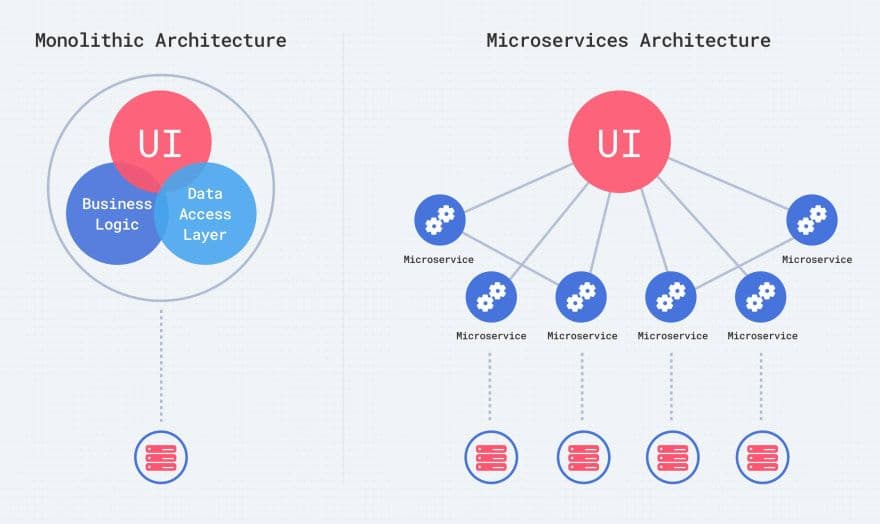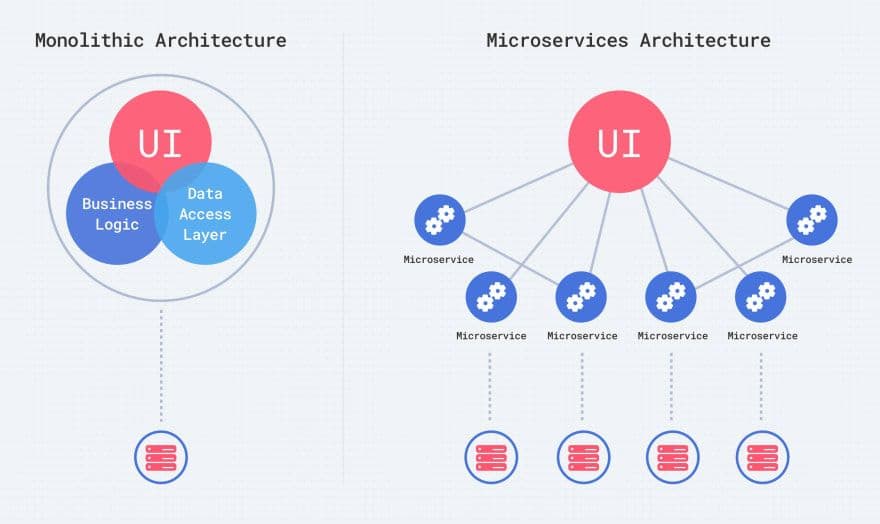Monolith vs Microservice architecture

Introduction
As a business person, it’s crucial to understand the technological choices that impact your organization. This article will discuss two prevalent software architecture patterns: monolith and microservices. We’ll provide an overview of both architectures, their benefits, and their drawbacks to help you make informed decisions for your business.
Monolith Architecture
A monolithic architecture combines all components into one interconnected, interdependent application. The user interface, business logic, and data access layers form one tightly-coupled system in a monolith.
Pros of Monolith Architecture
Simplicity: Monoliths are simple to develop and deploy, as all components are part of a single codebase. This makes it easier for developers to understand the system and make changes, which can accelerate development time.
Consistency: Tightly-coupled monolith components ensure a consistent look and feel across the application, leading to a more cohesive user experience.
Performance: With all components residing in the same application, communication between them is fast and efficient, which can lead to better overall performance.
Cons of Monolith Architecture
Scalability: Scaling monoliths can be challenging, as you must scale the entire application together. This may lead to inefficient resource allocation and significant investments in infrastructure to accommodate growth.
Flexibility: Due to the tight coupling between components, making changes to a monolith can be time-consuming and error-prone. This can slow down the development process and make it difficult to respond quickly to changing business requirements.
Resilience: In a monolithic system, a failure in one component can impact the entire application, leading to decreased resilience and reliability.
Microservices Architecture
A microservices architecture builds a system as a set of small, independent services, with each responsible for specific functionality. These services communicate through APIs, allowing independent development, deployment, and scaling.
Pros of Microservices Architecture
Scalability: Microservices can be scaled independently, allowing for efficient resource allocation and reduced infrastructure costs. This makes it easier to accommodate growth and adapt to changing business needs.
Flexibility: With each service responsible for a specific functionality, developers can make changes to individual services without impacting the entire system. This enables faster development and easier adaptation to new requirements.
Resilience: In a microservices architecture, a failure in one service is less likely to affect the entire system, improving overall resilience and reliability.
Cons of Microservices Architecture
Complexity: Developing, deploying, and maintaining a microservices-based system can be more complex than a monolithic one. This may require a higher level of technical expertise and investment in appropriate tooling and infrastructure.
Performance: Communication between services in a microservices system can be slower than in a monolith, potentially impacting performance. However, this can be mitigated through careful design and optimization.
Consistency: Ensuring a consistent look and feel across a microservices-based system can be more challenging, as each service is developed independently. This can require additional effort to maintain a cohesive user experience.
Conclusion
Both monolithic and microservices architectures have their pros and cons, and the right choice depends on your business requirements and goals. Monoliths offer simplicity and consistency, making them suitable for small to medium-sized applications with relatively stable requirements. Conversely, microservices provide better scalability, flexibility, and resilience, which may be more appropriate for larger applications or those with rapidly changing requirements.
When deciding between monolith and microservices, consider factors such as application size and complexity, your team’s technical expertise, and your organization’s growth projections. Weigh the pros and cons carefully and consider long-term implications, as migrating from one architecture to another can be complex and costly.
In some cases, a hybrid approach that combines elements of both monolithic and microservices architectures might be the best solution. For example, you could start with a monolithic core and gradually transition specific components into microservices as your business needs evolve.
Ultimately, it’s crucial to maintain open communication between business stakeholders and technical teams, ensuring that all parties understand the implications of the chosen architecture. By fostering collaboration and staying informed about technological advancements, your organization can make the best decisions for its unique needs and continue to thrive in today’s competitive business landscape.


